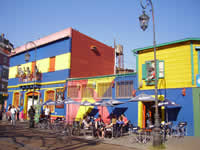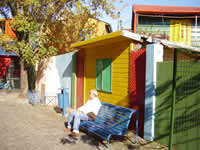As varied is Argentina’s geography, so is its culture. It is composed of an ethnic mix of foreigners from Europe, especially immigrants from Italy and Spain, which can be noticed in the Argentine culture, architecture and kitchen, and even in the way people speak. Other cultures as well established their own role throughout the country—the Basque and Irish controlled sheep farming, Germans established farms, and the British predominately invested in developing the country’s infra-structure. Small populations of Japanese, Chileans, Peruvians, Bolivians, Paraguayans, and Uruguayans are also found scattered throughout the country.

Due to the array of cultural diversity, this makes for particularly diverse arts, crafts, and music. Cinemas and galleries are ample in major urban centers, and are visited by people of all ages. The Argentine cinema has accomplished international standard and is used among other things as a vehicle to manifest the horrors of the Dirty War. Especially in Buenos Aires, Tango is the medium of dance and is believed to be one of the most amorous ways of expressing love in Argentina. Folk music is also popular, containing Amerindian influence.
Most cities have both very modern and very classical parts, and the colonial influences from throughout Europe give unique characteristics to each city. More than one third of the country’s 32 million residents live in Buenos Aires, the capital. A small population of natives still live in the country, mainly the Quechua in the northwest region and the Mapuche in Patagonia.
Soccer is the past-time of choice, where Argentina has won the World Cup twice, once in 1978 and again in 1986. Diego Maradona is a national hero due to his great soccer skills.

Roman Catholicism is the official religion of the country, where spiritualism and devotion of the dead are also deep-seated as well. Pilgrimages are not uncommon to the grave sites of relations and famous people who have since passed away. Judaism also makes up of a percentage of the religions found in Argentina.
The official language of the country is Spanish, however, the Spanish in Argentina is different from the Spanish spoken in most countries in South America due to the use of ‘vos’ instead of ‘tú’, the different pronounciation of ‘y’ and ‘ll’, and the strong italian intonation people use.
As for food, Argentina of course is famous for its high quality meat, usually cooked on mixed grills known as parrilladas, and served in huge portions. Apart from this, empanadas, pizzas and Italian pastas are incredibly popular among the local people, while vegetarians will meet a great offer of vegetable pies and colourful salads. Another delicacy brought by the Italians is ice cream, which is enormously popular among both tourists and locals, the whole year round. And last but not least, you can’t leave Argentina without trying the ever present ‘mate’, a green herb tea served usually in a calebas with a metal straw which is passed on to the people in the group. Drinking mate therefore has a very strong social caracter and is usually accompanied by endless chats, although the Argentines will also drink it by themselves, at any time and wherever they are.